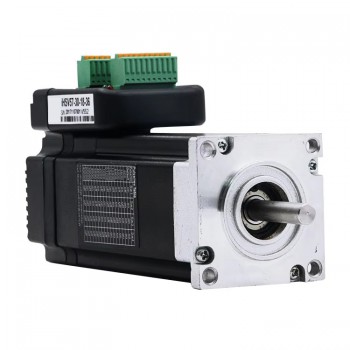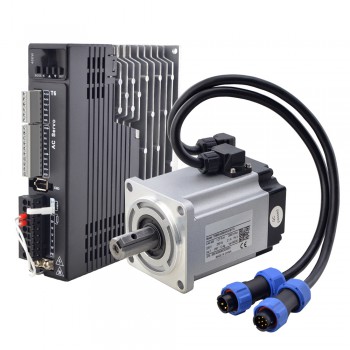Main advantages and selection criteria of servo motors
2024/12/26 17:07
瀏覽42
迴響0
推薦0
引用0
1.Brief introduction of servo motors
Servo motors are motors that control the operation of mechanical components in servo systems, and are characterized by high precision, high speed and high efficiency. It can convert voltage signals into torque and speed to drive the controlled object. The servo motor drives the load to move by receiving control signals, and detects parameters such as the position, speed and acceleration of the load in real time through sensors, and feeds back to the controller for adjustment, thereby achieving high-precision control.
2.Working principle of servo motors
The working principle of servo motors is based on rapid response and control of input signals. Its core lies in accurately controlling the speed and position of the motor through electrical signals. After receiving a pulse signal, the servo motor will rotate a corresponding angle to achieve precise positioning. Since the servo motor itself has the function of emitting pulses, a corresponding number of pulses will be emitted for each angle of rotation, thus forming a closed-loop control with the received pulses, ensuring the accuracy and stability of the system.
3.Main advantages of servo motors
1.High-precision control: The servo motor adopts a closed-loop control system, which uses an encoder or other sensor to feedback the position information of the motor rotor in real time, compares it with the input command, and adjusts the input signal of the motor through the control system to achieve precise position, speed and acceleration control. This closed-loop control mechanism significantly improves the control accuracy of the servo motor and is suitable for occasions with extremely high position accuracy requirements.
2.High performance: The servo motor has excellent high-speed performance and overload resistance. The general rated speed can reach 2000~3000 rpm, or even higher, which is suitable for occasions requiring high-speed movement. Its strong overload resistance ensures the stable operation of the motor under complex working conditions. In addition, the servo motor can also remain stable when running at low speed, and there will be no stepping phenomenon, which is suitable for occasions requiring high-speed response.
3.High efficiency and energy saving: Servo motors usually have high energy conversion efficiency, which can convert more electrical energy into mechanical energy and reduce energy waste. At the same time, the servo motor can automatically adjust the power output according to the load conditions, effectively reducing unnecessary energy consumption.
4.Flexibility and adaptability: Servo motors can achieve different motion modes and control effects by adjusting control parameters, and have high flexibility. Its high precision, high performance and flexibility make servo motors widely used in industrial automation, aerospace, medical equipment and other fields.
5.Maintenance and reliability: The structure of servo motors is relatively simple, and the modular design makes maintenance and replacement of parts easier. Its high-quality materials and manufacturing processes ensure the high reliability and durability of servo motors. At the same time, the closed-loop control system can detect and correct potential problems in time to ensure the stable operation of the motor.

4.Selection criteria for servo motors
1.Load torque and inertia: When selecting, it is necessary to consider factors such as load inertia, friction, gravity, etc. to estimate the load torque and inertia. The rated torque of the motor should be greater than the required torque, and the maximum torque should be able to meet the requirements during acceleration. The inertia ratio is the ratio of the motors own rotor inertia to the load inertia. The smaller the inertia ratio, the better the motor performance and the easier the control.
2.Response speed and position accuracy: The response speed and position accuracy of servo motors are their important characteristics. The higher the speed, the faster the response, but the power consumption will also increase. The higher the resolution, the higher the control accuracy.
3.Operating environment: The selection of servo motors also needs to consider their operating environment, such as temperature, humidity, vibration and other factors. These factors will affect the performance and life of the motor.
4.Encoder type: Servo motors are usually equipped with encoders to provide position feedback. Encoders can be divided into absolute and incremental types. Absolute encoders are further divided into battery-type and battery-free types. The former can maintain position information after power failure, while the latter requires repositioning.
5.Driver type: Servo motors are usually used in conjunction with drivers, which are divided into pulse type and bus type. Pulse type drivers are suitable for simple control requirements, while bus type drivers support more complex communication protocols and can achieve higher levels of control and monitoring functions.
6..Connection method: The connection between the servo motor and the driver includes power line, encoding line and brake line. The power line is responsible for transmitting electrical energy, the encoding line is used to transmit position information, and the brake line is used to brake the motor when needed.
自訂分類:不分類
上一則: Energy-saving measures and maintenance methods for hollow shaft stepper motors下一則: Debugging steps and optimization methods of closed-loop stepper motors
你可能會有興趣的文章:
- How to maintain an integrated stepper motor?
- Design points and maintenance measures for stepper motor encoders
- How to extend the service life of helical planetary gearboxes
- Debugging steps and optimization methods of closed-loop stepper motors
- Características de diseño de los motores paso a paso bipolares
- Characteristics and application fields of DC gear motors
限會員,要發表迴響,請先登入



